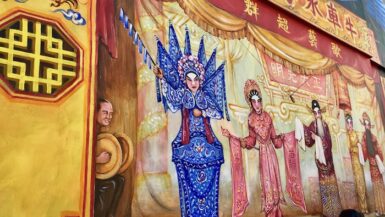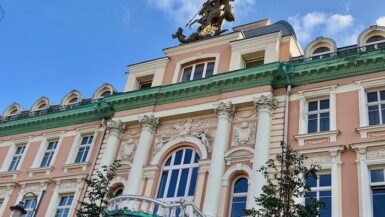August 27, 2019
Markets and food halls fascinate me, so when we did our whirlwind visit to the Central Market yesterday on the free walking tour, I knew I had to go back for a slower exploration. Getting to the market is the only unpleasant part of the trip because you have to walk through the underpass. While it’s no dirtier than most underpasses, it has a distinct aroma (if you know what I mean). There may be another way to get from the apartment to the market, but this was the only route I knew, so I took a deep breath and forged ahead.
The outdoor market was in full swing. From what I could tell, you could buy almost anything you wanted except for building materials and large appliances (although they may be there and I just didn’t see them). I wasn’t in a shopping mood, so I walked quickly through the rows of clothing and shoe vendors to get into the first market hanger.

While I did see some of the more unsavory portions of animals in a few stalls, the meat hanger was very well organized and the use of cooled display cases would be a relief if I was on the hunt for something to cook for dinner. The hanger felt like a giant supermarket of meat. Everything was on offer from game meats (rabbit, venison, etc.) to sausages – so many types of sausages. I think you could eat a different sausage every day of the month and still have more varieties to try.
The second hanger is basically just a pass-through these days as it is under reconstruction. Our guide yesterday told us that they are meticulous about keeping everything repaired and in high working order because it is a place that the entire city comes to many times throughout the week. When not under construction, it’s the hanger for dairy products (and probably eggs).

Some of the displaced vendors have wedged into the third hanger, which normally contains miscellaneous product vendors (bakery, herbs, teas, honey, medicines, etc.) and the food hall.
If truth be told, the food hall was my primary destination today. I didn’t know what type of food I wanted, but I was hungry. There were so many choices, although Asian flavors seemed to predominate.
I walked around looking at what other people were eating, trying to make a choice. What did I settle on? Why, when in Latvia, what else would one eat but … Georgian food.
I found the lone vendor serving khinkali and khachapuri. I would have preferred to get a plate of khinkali (dumplings), but they were making them by hand and the wait was 30 minutes. Instead, I ordered adjaruli khachapuri, basically cheese bread with an egg in the middle. The wait for the bread was only 15 minutes, but it too was handmade on the spot. It definitely brought me back to happy times in Tbilisi. No wonder Georgian food is becoming more and more popular. I did wish though that I’d waited the extra 15 minutes for khinkali because other peoples’ orders looked amazing.
Fully sated, I toured the remaining hangers looking at the wonderfully fresh produce and the fish. Oh, did I mention that they pickle everything – there were lots of “pickle” vendors. The hangers are so huge that you could spend hours slowly perusing your options and still not make it all the way through.
It’s a wonderful alternative to going to the supermarket, although they seem to do a swift business as well – they are always busy.
I had a bit of time before my afternoon walking tour, so I ambled through a couple of parks along the canals (keeping my eyes out for friendly beavers), took a multitude of pictures, pondered some of the statues, and finally arrived at the Opera House.
I still time, so I visited the ticket office of the Opera House to see what was playing the next two nights. While there was nothing on stage tonight, the ballet company was presenting Pie Zilās Donavas, or The Blue Danube. A Google search revealed that this ballet was a favorite of the Latvian National Ballet, so I figured why not see it. There weren’t a ton of tickets available, but the prices for the remaining ones weren’t bad ranging from 7 to 35 euros. I’ll be going to the ballet tomorrow night. Thank goodness I packed a dress.
The afternoon tour guide was once again Liga from Riga Free Tours. This tour was touted as focusing on Art Nouveau in Riga. Architecture and art wrapped up into one, yes, please!
Liga told us that we would be seeing three different styles of Art Nouveau – Decorative (the most popular and plentiful), national romanticism, and Riga perpendicular (the least favorite).
The first example was on our way out of the old town. Built in 1904 by a merchant and vintage book collector, the building is done in the decorative Art Nouveau style. The owner wanted it to be practical and beautiful, so the first floor was designated for shops, the second floor was for offices and the remaining upper floors were designed as apartments. Today, the building is occupied by the Italian embassy.

Perhaps the most famous residential building in Riga is called The Cat House, due to the cat sculptures on its roof. While there is a legend involving the owner turning the butts of the cats towards the guild across the street when they wouldn’t admit him, the building was not constructed until 1908, so it’s just a myth. Anyway, the cats are a result of the owners’ desire to have animals incorporated into the design. Liga said the apartments inside are large, but they are very expensive, so the locals aren’t the ones renting them.
Just outside the old town is the Academy of Arts, a very prestigious and difficult university to get into. Although the exterior of the school is neo-gothic architecture, the interior is Art Nouveau. We have to take Liga’s word for it because visitors are not allowed in. It wasn’t always an arts academy; it was originally built as a Jewish finance school.

Many fine examples of Art Nouveau buildings are grouped on two streets Alberta iela and Elizabetes iela. Several of the most notable were designed by the same man – Mikhail Eisenstein. Mr. Eisenstein was a Russian civil engineer who settled, along with his extremely wealthy and well-connected wife, in Riga. Despite his job in city planning, his passion was designing the facades of buildings. While he excelled in that portion of architecture, construction wasn’t his forte and, as a result, many of the balconies and even the floors of the buildings aren’t exactly level. But they are beautiful.
Eisenstein, born into a Jewish family but converted to the Russian Orthodox Church, had a motto – “decoration comes before the practical.” Thus, all of his buildings fall into the decorative Art Nouveau category. Apparently, the interiors of the buildings he designed are nothing to write home about – all of his energy was put into the exteriors.
Eisenstein also loved to draw faces (usually angry faces), loved mythology, and loved naked women. Each of these passions is quite evident in the building facades.
So, what about the other styles? We walked by an example of Riga Perpendicular mixed in between decorative buildings. The style uses vertical lines, large windows and typically has portions of rooms that stick out from the vertical lines of the building, like squared-off bay windows. This style is more about the interiors than the exteriors. They have high ceilings, lots of windows for light and many more interior details than the decorative style. These buildings were also the first to have modern elevators and modern bathrooms. It was all about beautiful living, not just exterior beauty.

Then there’s the Latvian national romanticism style, which is not that beautiful so I’m not sure what is so romantic. In this style, all the materials used must come from Latvia, the architect must be from Latvia, and I suppose those doing the construction should come from Latvia. Dark colors are used, as are many types of materials such as wood, cement, iron, etc. Additionally, decorative touches represent nature and pagan symbolism is also given a nod. The sole example on Alberta Street at No. 11 has fallen into disrepair, as the owner hasn’t kept it up. As a result, the rent is extremely cheap; however, even starving students don’t really want to live there.
We ended our tour at the end of Alberta. On my walk back to the apartment, I continued to stop and look at details of buildings along the way. Riga is so full of awesome buildings. I’m sure I could spend lots of time just wandering the streets. Maybe another time.






























































